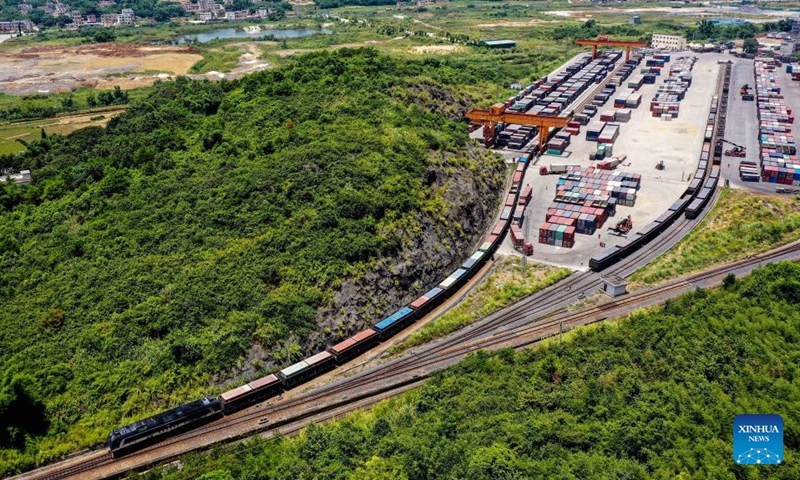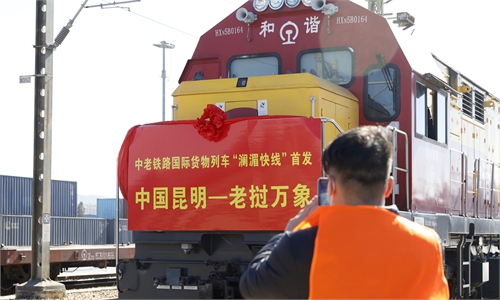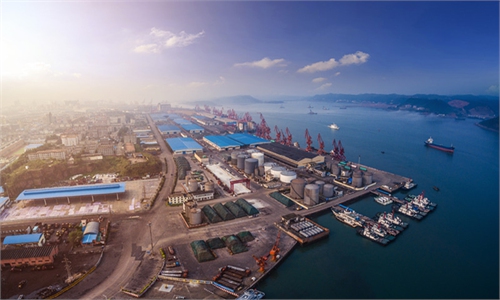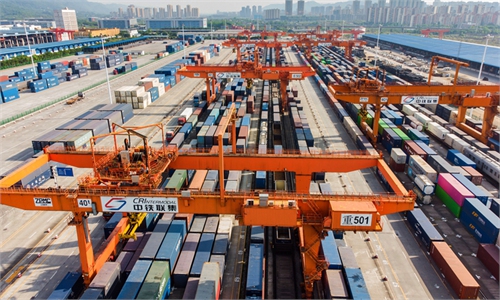
Aerial photo taken on July 29, 2022 shows an outbound freight train at a railway freight center in Wuzhou, south China's Guangxi Zhuang Autonomous Region. Launched in 2017, the New International Land-Sea Trade Corridor is a trade and logistics passage jointly built by western Chinese provinces and ASEAN countries. (Xinhua/Zhang Ailin)
With the launch of a cargo train from the Port of Qinzhou in South China's Guangxi Zhuang Autonomous Region to Lhasa in Southwest China's Xizang Autonomous Region, more and more localities in China are embarking on land-sea multimodal transportation services, which offer faster connections among regional countries.
Freight train X9574, loaded with apparel, shoes and other daily necessities, left the Port of Qinzhou for Nepal on Saturday. The trip will take two weeks, and the cargo will be transported via road to Gyirong at the China-Nepal border. Compared with traditional seaborne travel, the new multimodal method can get goods to customers some 20 days faster, according to domestic news portal people.com.cn on Sunday.
The launch of the train brought all the participants under a framework to jointly develop a new western land-sea corridor to deepen the sea-land two-way opening-up and the development of western China.
So far, 13 provincial-level localities and two cities have opened at least one logistics link tapping the increasingly popular land-sea multimodal option, which combines rail, sea and road traffic.
The new trend is happening, while China's trade and investment ties with ASEAN keep growing, as companies from regional countries receive benefits from the Regional Comprehensive Economic Partnership (RCEP) mega trade deal.
Between January and August, China-ASEAN trade reached 4.09 trillion yuan ($590 billion), up 14 percent year-on-year and outstripping a 10.1 percent overall trade growth. It accounted for 15 percent of China's total foreign trade, customs data showed.
Bai Ming, deputy director of international market research at the Chinese Academy of International Trade and Economic Cooperation in Beijing, told the Global Times on Sunday that the new western land-sea corridor offers customers a faster alternative to send goods among countries in the region.
The corridor links the Silk Road Economic Belt and the 21st Century Maritime Silk Road, Bai said, noting that railways offer more stable rates compared with sea freight rates, which soared in recent years and receded in recent months.
A group of provinces in western China signed the framework on the new western land-sea corridor in October 2019. According to an overall plan by the National Development and Reform Commission, China aims to build an economical, efficient, convenient, green and safe land-sea corridor for the western region by 2025, with rail-sea multimodal shipments reaching 500,000 standard containers a year.
The new western land-sea corridor has evolved over the years, with three main arteries, reaching 335 ports in 113 countries and regions, the report said, citing a railway manager with China State Railway Group. The variety of items transported also expanded to more than 640 from 50 in 2017.
The corridor slashed the time required for goods from ASEAN to reach China's western provinces by about 10 days to around 20 days.
Since January this year, 13 signatories of the RCEP deal have utilized the corridor, according to the report on people.com.cn.
Containers handled via the rail-sea multimodal transportation system at the new western land-sea corridor totaled 519,600 as of September 13, up 23.8 percent from the corresponding period in 2021, the report said.




